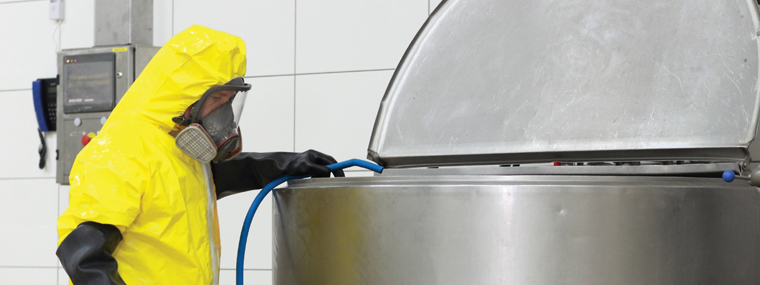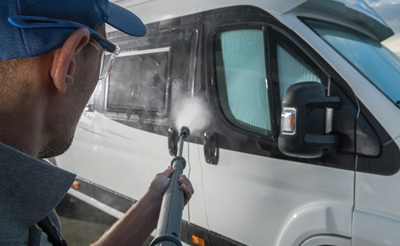
Heed the Call—Maintain Your Equipment
By Diane M. Calabrese / Published April 2021

A feeling for a machine? Why not?
Use a tool often enough—smartphone or pressure washer—and it’s easy to sense when something is amiss. A strange noise is a big clue. Sluggish response is another.
But outside a realm with a sixth sense, relying on the standard five senses to keep pace with equipment maintenance is not a plan. A methodical approach is.
“Early on in my pressure washing career, I learned the hard way about winterizing our equipment,” says Chris Watson, owner of WNC Pressure Washing located in Maggie Valley (greater Asheville), NC. “We live in western North Carolina, and I figured if I ran the tank empty there would be no water to freeze.”
It did not work out the way Watson imagined. “Next season, when I used the pressure washer, I had water spewing out from every space possible,” he explains.
Watson tapped help from other contractors, distributors, and manufacturers who share information via the internet. “I started to Google the correct way to prepare for freezing weather. I read a few articles, but I found some very helpful videos on YouTube showing great remedies.”
What works for Watson? “I learned to use RV antifreeze or blow air through the system,” he says. “Using antifreeze is better for long-term storage over using air because it helps keep the internal parts lubricated.”
Because it’s possible for water to freeze on a short trek between worksites, Watson remains vigilant. “Over the years, we have acquired a lot of commercial jobs that require us to work during the cold winter months,” he says. “Sometimes even when driving from one job to another the water can freeze.”
To prevent ice from forming, Watson relies mostly on air. “Our pressure washer is located on our truck along with the burner,” he explains. “Due to the cost of having to purchase antifreeze every time we used the machine, we found that blowing air through the entire system was the most effective way to prevent freezing for us.”
Experience is a powerful teacher. Watson’s account demonstrates that.
Take advantage, too, of the information that distributors and manufacturers provide with their equipment. The sellers and makers provide advice because they want their customers to succeed. That success starts with equipment that functions optimally.
Dultmeier Sales LLC in Omaha, NE, serves customers across a wide range of industries, such as agriculture, car and truck wash, and petroleum. Mike Hansen, sales manager—water division at the company, says there is basic maintenance advice imparted to equipment buyers with each purchase.
To keep a pressure washer in top form, commit to giving it the attention it deserves. “On a daily basis check hoses and trigger wands for damage,” says Hansen.
Look closely, explains Hansen. “Do hoses show any breaks or excessive wear in the outer cover? Can wire braids be seen or felt protruding from the cover? Are there any leaks from trigger wands or swivels?”
Scrutinize the power behind the flow, too. “Check pumps for leaks,” says Hansen. “Listen to pumps while operating them—is there any noise that could be due to excessive cavitation, supply hose issues, tanks, fittings, or wear on the pump’s seals?”
Hansen reminds us there can be cascading problems. “Inlet water supply issues can starve pumps and cause premature wear to seals.”
Assess pressure, says Hansen, “Is the pump output pressure where it should be? Keep in mind that normal pressure loss occurs as nozzles wear due to use.”
What about lubrication? “For new pumps, change oil after the initial 50 running hours and then every 500 hours after,” says Hansen.
Cold or hot pressure washers both require the same basic attention. Do one thing more for hot water machines, says Hansen. “Check temperature output to the wand. Are the burner and coil performing to your output needs?”
Timely and Safe
Manufacturers are also a good resource for contractors. “We urge all customers to understand the proper operation of their pressure washer and how important maintenance is,” says Chris Smith, national service director at FNA Group (maker of the brands Simpson® and Delco®) in Elk Grove Village, IL.
“Taking a few extra minutes for routine maintenance keeps downtime to a minimum,” says Smith. “You will not just be more efficient but will also keep the pressure washer in top form.”
Adhere to the manufacturer’s recommendations to get the most from a piece of equipment. After all, the manufacturer has designed and tested it so that a contractor or other end user can maximize results.
“We encourage all our customers to follow the recommendations we have when it comes to service intervals,” says Smith. “All our pressure washer manuals will have this data and can easily be found online on our website.”
Ultimately, maintenance accomplished as prescribed saves hours. “The time and cost of changing oil, for example, pales in comparison to the cost of damaged parts,” explains Smith.
For contractors who must pause for the winter, haste in storing equipment can be costly. Take the required steps.
“We always recommend winterizing your pressure washer pump at the end of the season,” says Smith. “Our product, Pump Guard, is perfect when storing a pressure washer for more than 30 days.”
The product Smith cites meets multiple goals. “It protects the pump and other components from damage caused by long storage periods and cold temperatures down to minus -25°F,” he explains. “It also minimizes harmful corrosion by lubricating valves, seals, and pistons to prevent sticking.”
End of season maintenance is a serious matter. “Winterize your pump at the end of every season, and your pump will be ready to take on the next one,” says Smith.
Optimal performance and time savings (avoiding breakdowns) may be the immediate objectives when maintaining equipment. Longevity and safety must be added to them.
When a machine works well and realizes its full life expectancy, it becomes as cost-effective as possible. That is a boon to the bottom line.
So is safety. Moreover, safety is an expectation. Near the top of the list of employer responsibilities outlined by the Occupational Safety and Health Administration (OSHA) is this one: “Make sure employees have and use safe tools and equipment and properly maintain this equipment.”
The only two responsibilities that rank higher are those focused on providing a workplace free from serious and recognized hazards, and routine examination of a workplace to make certain it meets OSHA standards. Of course, equipment that functions properly must be part of a safe workplace.
Whether abridged as checklists or fleshed out as standard operating procedures (SOPs), reminders beyond memory strengthen the effort to maintain equipment. Developing a routine maintenance list or SOP is also a good way to get to thoroughly know each machine.
Start with what the manufacturer recommends, but don’t be afraid to add or rearrange. Inspect. Clean. Change. Those are the basics. Subdivide as appropriate, such as daily, weekly, or monthly tasks. Charts work best for some because checkoffs can be done to record that the inspection, cleaning, or changing has been done.
The maintenance setting is as important as the maintenance itself. Pulling a pressure washer off a truck at a jobsite and taking a critical look at its components may work, but with distractions from traffic to team members’ questions, it’s best to do the inspection before leaving home base.
In fact, the inspection at home base should also include the vehicle. At a jobsite, be sure to inspect anything that could disrupt a piece of equipment. Do a multimeter check on the power supply before plugging in an electric pressure washer. If not carrying water, check the source (condition) of the supply to be used on site.
Structured lists or SOPs may seem excessive, yet they save contractors time and money. Forget or delay an oil change, and the friction that builds can accelerate wear. (It also increases energy use.) Dirty engines/motors can become fire hazards, although we don’t expect any readers here to allow that much buildup of residue.
Something as simple as the routine of ascertaining that every hose and trigger coupling is tightened appropriately is a must and must be done scrupulously. New team members, particularly those new to working with machines, benefit from reinforcement of what seems obvious to veterans of the industry. Give them the assistance they need with the checklist or SOP.
Finally, recordkeeping on machines should include when routine changes (e.g., oil, filters, hoses) are done as well as when a significant maintenance issue and its correction occurred. For contractors with many team members, it’s not a bad idea to have one person assigned to one machine (and one vehicle). Such assignment can improve the interest each person takes in maintaining equipment. And, it’s easier to track down lapses in attention to equipment and who’s responsible.
Although it’s not a sixth sense, never discount common sense. When a machine that has been thoroughly inspected sputters, squeals, or otherwise sends a distress call, heed the call.
A methodical approach partners well with the voice of experience saying “Something is wrong.”







